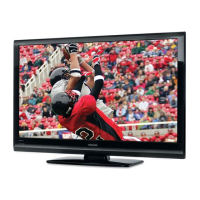
Do you have a question about the Toshiba Regza 42XV545U and is the answer not in the manual?
| Screen Size | 42 inches |
|---|---|
| Display Type | LCD |
| Backlight Type | CCFL |
| Contrast Ratio | 3000:1 |
| Response Time | 8 ms |
| HDMI Ports | 3 |
| USB Ports | 1 |
| Audio Output | 10W x 2 |
| Aspect Ratio | 16:9 |
| Component Video Inputs | 2 |
| Composite Video Inputs | 1 |
| S-Video Inputs | 1 |
| PC Input | 1 |
| Resolution | 1920 x 1080 |
| Brightness | 500 cd/m² |
| Viewing Angle | 178° |
| Input Ports | HDMI, Component, Composite, S-Video, PC |
Section to record model and serial numbers for future reference.
Tips for safe use of flat panel displays and furniture placement.
Further safety advice regarding electrical shock, fire, and handling damaged units.
Recommendations and precautions for installing the TV.
Guidelines for servicing the TV, including warnings about user repair and mercury content.
Instructions for safely setting up the TV on its pedestal stand.
Guidelines for wall mounting the LCD TV, emphasizing safety and proper bracket use.
Highlights key features of the Toshiba LCD TV, including digital tuning and HDMI capabilities.
A step-by-step guide to setting up and using the TV.
Details of the TV's front and side panel controls and connection ports.
Explanation of all connection ports located on the back of the TV.
Description of various cable types used for connecting devices to the TV.
Note on representative illustrations and referring to device manuals.
Instructions for connecting VCRs, antennas, and camcorders to the TV.
Guide for connecting DVD players, VCRs, and satellite receivers using component video.
How to connect devices for remote control via the TV's IR OUT terminal.
Instructions for connecting HDMI or DVI devices to the TV's HDMI input port.
How to connect audio receivers and playback devices for control via REGZA LINK.
How to connect a digital audio system to the TV's DIGITAL AUDIO OUT terminal.
How to connect external speakers to an external analog amplifier.
Connect a PC to the TV via PC IN or HDMI terminals for display and audio.
Information on the remote control's capabilities and preprogrammed functions.
Instructions for installing batteries into the remote control.
Explanation of the TV-specific buttons on the remote control.
A comprehensive chart detailing remote control button functions for various device modes.
How to use the TV remote to control other devices like cable boxes, VCRs, and DVD players.
Step-by-step guide on how to program the remote control for non-Toshiba devices.
Method to find device codes when the specific code is unknown.
How to lock volume control to a specific device mode.
How to reset programmed features and volume lock settings.
List of device codes for various TV brands for remote control programming.
List of device codes for various cable box brands.
List of device codes for various satellite receiver brands.
Device codes for DVD/VCR combo units.
List of device codes for various VCR brands.
Device codes for audio amplifiers and tuners.
Device codes for CD players.
Device codes for DVD-R devices.
Device codes for Personal Video Recorders (PVRs).
Device codes for Cable/PVR combo units.
Device codes for audio amplifiers.
Overview of the TV's main menu structure and icons.
Guide to the layout of the Setup/Installation menu.
Explanation of the THINC menu for accessing specific features.
Instructions on how to use the remote control to navigate the TV's on-screen menus.
How to enable or disable the TV's demonstration mode.
How to choose the language for on-screen menus and messages.
Steps to set the ANT/CABLE input source to Antenna or Cable.
Methods for programming channels into the TV's memory.
How to manually add or remove channels from the TV's memory.
How to enable automatic input switching using the remote control's MODE SELECT buttons.
How to assign channel labels or create custom labels for inputs.
Steps to create and assign custom labels using the on-screen keyboard.
How to delete custom channel labels.
How to select the audio mode for HDMI inputs.
How to check the signal strength of digital TV channels.
How to set the correct time zone and Daylight Saving Time status.
How to view system information and software version.
Procedure to reset all TV settings and channels to factory defaults.
How to turn the TOSHIBA logo illumination on or off.
How to choose between Power-Saving and Fast modes for TV startup.
How to set the TV for optimal energy efficiency to meet ENERGY STAR qualifications.
How to enable or disable the TV's demonstration mode.
How to choose which connected device's video signal to display on the TV.
How to assign custom labels to video input sources for easier identification.
Using the Channel Browser for easy navigation of channels and inputs.
How to create and manage a list of favorite channels and inputs.
Configuration options for the Channel Browser, including history and input lists.
How to tune channels or inputs while browsing the Channel Browser.
How to tune channels or inputs by selecting them in the Channel Browser.
Methods for managing channels and inputs in the History List.
How to set tuning preferences for analog and digital channels.
How to tune to the next programmed channel using the remote.
How to tune analog and digital channels using the number buttons.
How to switch between the last two tuned channels using the CH RTN button.
How to memorize a channel to the CH RTN button for quick recall.
Options for changing the picture size via remote control or menus.
How to adjust the scroll settings for TheaterWide 2 and 3 picture modes.
How to enable automatic picture size selection based on input source.
How to freeze the current TV picture.
How to select picture modes and adjust picture quality settings.
How to lock picture mode settings to prevent accidental changes.
Options for displaying dialogue captions or text information on screen.
How to customize closed caption display characteristics like color and opacity.
How to override analog caption mode or select digital caption services.
How to mute sound and select digital audio tracks.
How to select stereo sound or a second audio program (SAP) for broadcasts.
How to adjust bass, treble, and balance settings for audio quality.
How to limit volume level changes to prevent sudden shifts.
How to select the output format for the DIGITAL AUDIO OUT terminal.
How to compress dynamic range for consistent audio levels across broadcasts.
Features for PIN code entry, PIN change, and program blocking.
How to download and use an alternative rating system for program blocking.
How to block specific TV channels using the Channels Block feature.
How to temporarily unlock a program blocked by rating limits.
How to lock specific video inputs or channels to prevent unauthorized access.
How to set a time limit for video game sessions.
How to lock the TV's control panel to prevent accidental changes.
How to adjust picture settings when connecting a PC to the TV.
How to output or mute audio from a connected PC via the PC IN terminal.
How to set the TV to automatically turn off after a specified time.
Features for controlling connected REGZA LINK devices and selecting sources.
How to use the TV remote to control the volume of a connected Audio Receiver.
Overview of other REGZA LINK features like auto input switching and power on/off.
Feature that sets widescreen formats and picture preferences for REGZA LINK PC connection.
How to adjust HDMI-specific settings like Lip-Sync Latency, Deep Color, and x.v.Color.
How to display current TV status information using RECALL or INFO buttons.
Explanation of the TV's automatic power-off function.
How the TV remembers the last viewed mode after a power interruption.
How to select modes and adjust levels for upconverting SD content to HD quality.
How to adjust dynamic contrast settings to enhance picture quality.
How to adjust the levels of black in the picture.
How to choose from preset color temperatures (Cool, Medium, Warm).
How to set Cinema Mode to Film or Video for smoother motion.
How to enable ClearFrame for reduced motion blur.
How to eliminate video shaking when Cinema Mode is set to Film.
How to reduce visible interference in the TV picture.
How to reduce visible interference caused by MPEG compression.
How to automatically optimize backlighting levels based on ambient light.
How to adjust standard colors using the ColorMaster feature.
How to adjust Hue, Saturation, and Brightness of base colors.
How to enable x.v.Color for a wider color range.
How to reduce frame delay for video games.
Features for enhancing audio with Stereo Extension, Voice Enhancement, and Dynamic Bass Boost.
General advice for troubleshooting common TV problems before calling for service.
Solution for a black box appearing on screen, likely related to closed captions.
Steps to take when the TV becomes unresponsive to remote or panel controls.
General advice for problems not covered elsewhere, suggesting factory reset.
Troubleshooting steps if the TV fails to power on.
Troubleshooting common picture issues like connection problems and poor reception.
Tips for reducing noise in the TV picture, possibly using CableClear.
Troubleshooting steps if the Video Input Selection window does not appear.
Solutions for not being able to view external signals or specific channels.
Possible causes and solutions for color issues, including tint and color adjustments.
Advice for improving composite or S-video picture quality.
Potential causes and solutions for audio/video sync issues.
Explanation of the yellow LED blinking pattern during TV startup.
Troubleshooting steps for various sound issues, including muted sound and SAP broadcasts.
Common issues with the remote control and their solutions.
Troubleshooting steps for issues related to tuning channels.
Common issues with closed caption display and solutions.
Troubleshooting steps related to V-Chip rating blocking.
Solutions for problems with REGZA LINK functionality.
Troubleshooting steps for HDMI connections and features.
Explanation of the TV's status indicators (LEDs) and what they mean.
Technical specifications for the TV, including system, power, and terminals.
Physical dimensions of the TV models.
Weight specifications for the TV models.
Recommended operating temperature and humidity ranges.
List of items included with the TV package.
Tables listing acceptable resolution and frequency formats for PC and HDMI inputs.
Details of the one-year limited warranty for LCD TVs 26 inches and larger in the US.
Information on how to get warranty service and contact Toshiba.
Details of the one-year limited warranty for Toshiba flat panel TVs in Canada.
Warranty period for rental units.
Warranty terms for televisions used for commercial purposes.
Legal disclaimers and limitations of liability regarding warranties.
Terms regarding dispute resolution through arbitration.
Disclaimer regarding the TV's unsuitability for critical life-support applications.
General terms and conditions related to the warranty.
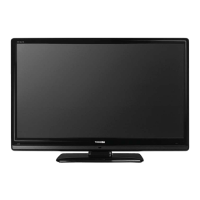
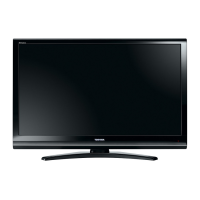
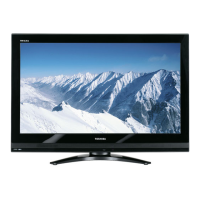
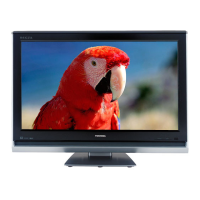
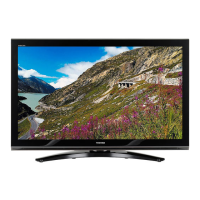
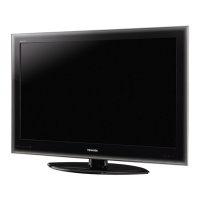
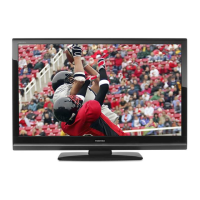
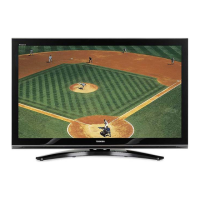

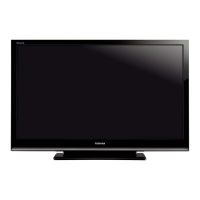


